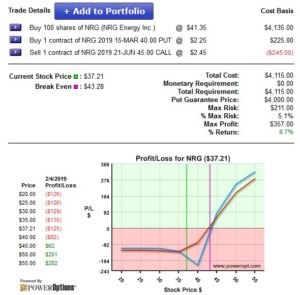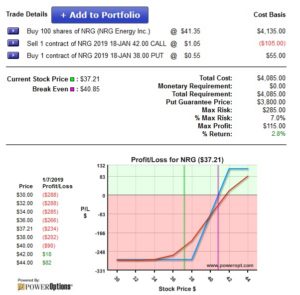I get these emails a lot: “I get protecting my stocks, but aren’t there better ways to limit risk on my stock?”
This of course is a response to seeing the initial RadioActive Trading structure: Buying a far out, slightly In the Money Put to protect your stock positions properly.
There are other ways, but are they necessarily better ways to limit risk? Each have pros and cons, so let’s take a look at 2 of the common comparisons:
Standard Collar:
In this Strategy one would combine the a covered call approach with a Married Put – in a sense.
One would:
Buy shares of stock
Sell an At or just Out of the Money Call (usually under 30 days out)
Buy a lower strike, Out of the Money Put (same expiration)
This creates a simple ‘hockey stick’ graph with a capped upside (much like a covered call) with a floor to the downside (due to the purchased put)
A credit is received (call premium is higher).
December 18th, 2018:
Buy 100 shares of NRG at $41.35
Sell 2019-JAN 42.00 strike call at -$1.05
Buy 2019-JAN 38.00 strike put at $0.55
Net premium gained = -$0.50
Max Return (stock above $42.00) = 2.8%
Max. Loss (stock below $38.00) = 7.0%
So this is a limited risk trade with potential upside, similar to a covered call. But is it a better way to limit risk? Let’s take a look at the pros and cons:
Pros:
- Income Generated Up Front
- Potential 2.5%+ gain in under 30 days
- Known, controlled, limited risk
Cons:
- More of a Fire and Forget trade
- Can be managed, but time is not on your side
- A few days in, during a bad market, we are near maximum loss
- Management is difficult here – may need to just wait for a recovery – or adjust to an expiration far out in time to make back the -7% hit taken.
I prefer Standard Collars over covered calls and naked puts – however, I do not think they are superior to a RadioActive Trading setup.
Alternative #2: The Reverse Calendar Collar
There are different names for this trade, but it is essentially a hybrid of the Collar.
In this strategy someone says:
- “Let me get better protection by purchasing an AT the Money put…”
- “And, let me get more time by purchasing that put 2-3 months out…”
- “Let me get more upside by selling a further out call for better premium…”
- “And let me sell that call higher in price for more upside!”
The idea is to solve the problems some immediately think they see with the RadioActive setup – And solve the problems of the ‘Fire and Forget’ Standard Collar.
Here is that structure on our same stock:
December 18th, 2018:
Buy 100 shares of NRG at $41.35
Sell 2019-JUN 45 (180 days out) Call at -$2.45
Buy 2019-MAR 40 (90 days out) Put at $2.25
Max. Risk (at MAR exp) = 5.1%
Max. Return (Stock above $60, MAR) = 8.7%
Interesting…
We get a (small) premium in this case, we see a low risk trade with a potential 9% or so upside gain – 90 days out in time. Why wouldn’t one do this?
Pros:
- Premium taken in upfront
- Low downside risk
- Potential for Adjustment
Cons:
- This P/L is only at March expiration. If I want to stay in the trade after March, I will have to buy a second put further out in time…adding to the cost. Increasing upper break even. Taking away from the call premium more. Lowering the gain, increasing the risk.
- Following the Time Value decay curve – the further out call won’t go to $0.00. If I want to liquidate, I will have to Pay to Close the call prior to JUN expiration.
- Gain and loss subject to Implied Volatility flux.
This strategy is predicated on managing the trade at the short term expiration or before. Most management will result in more money coming out of your pocket to either:
Stay in the position longer with a new bought put
Buy to close the still far out, JUN call, which still has time value
Close the Option Legs, buy further out put and sell further out call for premium…no in position longer with only a small increase in gains.
The Importance of the 3 Core Principles
The structure of this setup goes against a few Core Principles of Options Trading:
- When selling, I want to sell closer in (month by month or week by week) to increase annualized return.
- When buying, I want to buy farther out in time to lower annualized cost (option that is 6 months out is not 6X the cost)
- The ATM Bell Curve shows us that premium is highest At the Money (where I want to sell) and lower Out of the Money and In the Money (where I want to buy).
This structure is opposite of both of those principles:
- It involves buying insurance closer in and At the Money (top of the ATM Bell Curve)
- Selling premium further out in time and Out of the Money (lower annualized premium, lower Time Value received compared to At the Money).
Better Ways to Limit Risk?
Are there better ways to limit risk? Not in my opinion. I would rather have a protected structure that follows the 3 Core Principles of options Trading:
- Force an Ideal Sized Trade (F.I.S.T) – which all 3 do better than leveraged positions
- ATM Bell Curve: Not really solved by these two structures
- REDLine, or Time Value Decay: Kind of applied in a Standard Collar; opposite on the other structure.
This is why I prefer the RadioActive Setup to these other positions. The 3 Core Principles are already applied. Not just in the initial structure, but also in the 12 different Income Methods to adjust the trade discussed in The Blueprint.
But, that is my opinion. If you want to see more on these comparisons check out these videos:
Comparing Collar Structures and Alternatives to Married Put Entry:
This video is the opening of a Friday Open Discussion, where we take a look at a structure a customer is considering to limit risk long term, and compare against the RadioActive Structure and Collar #2: Click HERE to watch on YouTube!
3 Core and Trade Comparison – 2017. This video (full webinar) discusses in depth the 3 Core Principles of Options Trading, comparing against other structures including the In The Money Long Strangle as a ‘substitute’ for the RadioActive Trading technique. Click HERE to watch on YouTube!
As always, let me know your thoughts!
Special Offer Ends December 31st!
Over the years we have compared the RadioActive Trading approach against other limited risk structures:
The Standard Collar.
A Calendar Put – trying to get into the stock at a lower price.
The In The Money Long Strangle – why buy the stock at all, just but an ITM long call and Put!
A Long Call – Not the same. Not a true parity trade to the RadioActive structure.
The Reverse Calendar Collar – we discussed that here.
And many more. But from our experience the RadioActive Trading structure and 12 different income methods outperforms these other structures long term.
The only place where we discuss the full technique is in The Blueprint! And right now is the best time to pick up your copy, and take advantage of our End of Year Special.
Head on over to RadioActiveTrading.com/eoy to see more information and pick up your copy today!

 I'm Kurt Frankenberg, and I have discovered how to truly put the odds on the side on the individual investor.
I'm Kurt Frankenberg, and I have discovered how to truly put the odds on the side on the individual investor.